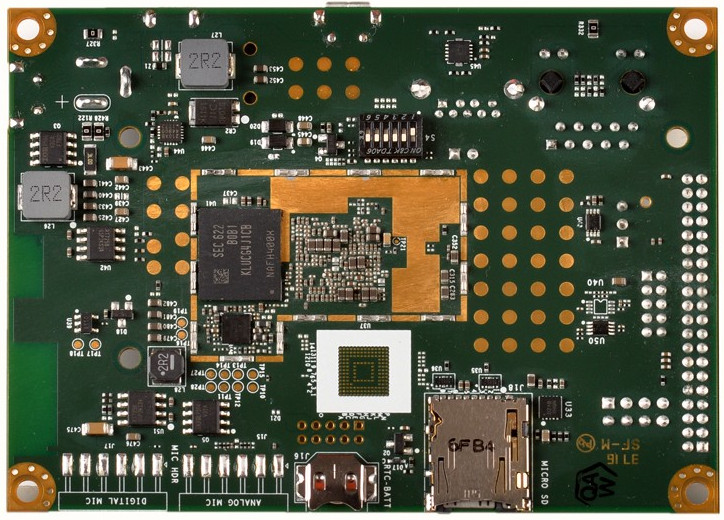We’ve already covered Qualcomm Snapdragon 820 system-on-modules such as Intrinsyc Open-Q 820 and Inforce 6601, which can be used with baseboards that are suitable for development, but so far I had not seen a single board computer (SBC) powered by the processor optimized for mass production and suitable for integration into products. Bu this is about to change, as three Snapdragon 820 SBCs are now (or soon will be) available with Inforce Computing 6640, iWave iW-RainboW-G25S, and DragonBoard 820c.
Inforce 6640 SBC
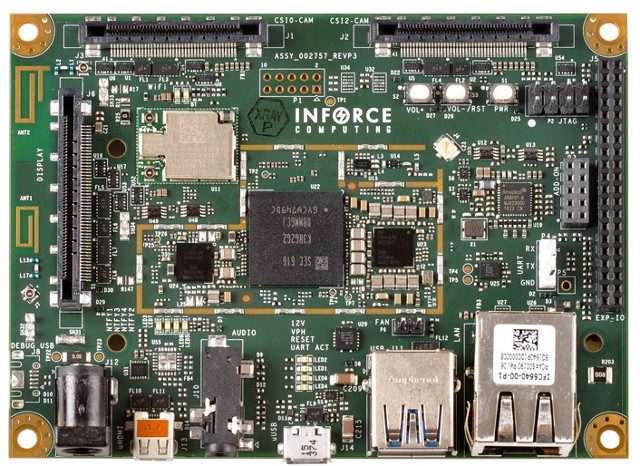 Inforce Computing 6640 Single Board Computer specifications:
Inforce Computing 6640 Single Board Computer specifications:
- SoC – Qualcomm Snapdragon 820 quad core Kryo processor with 2x cores @ up to 2.2GHz, 2x cores @ up to 1.6GHz, Adreno 530 GPU, Hexagon 680 DSP
- System Memory – 4GB LPDDR4
- Storage – Up to 64GB UFS 2.0 flash, microSD slot
- Video Output / Display Interface – 2x 4-lane MIPI-DSI DPHY 1.2 , 1x HDMI 2.0 interface for touch screen displays
- Audio – WDC9335 audio codec; 4x line out; 1x stereo headphone out; 3x mic in
- Camera – 2x 4-lane MIPI-CSI supporting sensors up to 28MP
- Connectivity – Gigabit Ethernet (Atheros 8151), 802.11ac WiFi + Bluetooth 4.2 LE (QCA6174A), GPS/GNSS module (WGR7640)
- USB – 1x USB 3.0 host port, 1x micro USB 2.0 OTG port
- Expansion – 34-pin “PAC” expansion header with I2C, SPI, UIM, UART, serial console, 12x GPIO
- Power Supply — 12VDC @ 3A; PM8996 PMIC, PMI8996 charger
- Dimensions — 100 x 70mm (Pico-ITX)
- Temperature Range – 0 to 55°C (commercial range)
The company currently provides Android 6.0.1 and Android 7.0 BSPs, but based on the comments section on a related Linux Gizmos article, Inforce Computing is working on a Linux BSP that should be released by the end of March.
Inforce 6640 board can be purchased for $289 directly on the product page, where you’ll also find some info, and some documentation.
iWave iW-RainboW-G25S
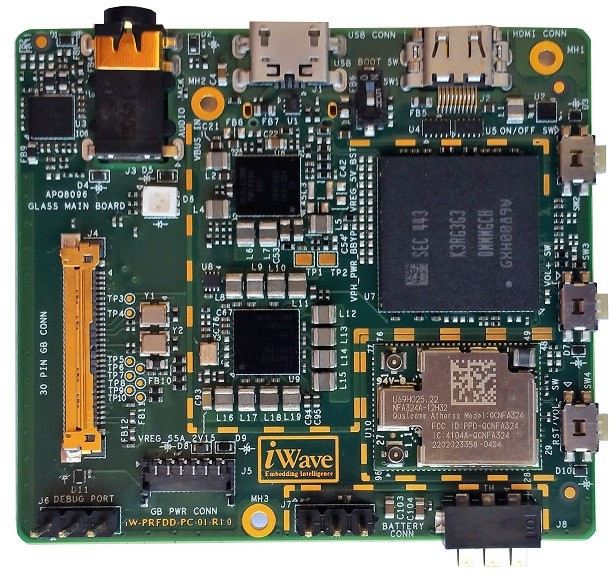 The second board of our list is made by iWave Systems Technologies, based in Bangolore, India, and comes with the following specifications:
The second board of our list is made by iWave Systems Technologies, based in Bangolore, India, and comes with the following specifications:
- SoC – Qualcomm Snapdragon 820 quad core Kryo processor with 2x cores @ up to 2.2GHz, 2x cores @ up to 1.6GHz, Adreno 530 GPU @ 624 MHz, Hexagon 680 DSP
- System Memory – 3GB LPDDR4 expandable to 6GB
- Storage – 32GB eMMC flash expandable to 128 GB, microSD slot
- Video Output / Display Interface – micro HDMI connector, 2 lanes MIPI DSI connector via 30P connector
- Audio – WCD9335 audio codec; audio in/out jack;
- Connectivity – 802.11 ac WiFi + Bluetooth 4.1, GPS (WGR7640)
- USB – 1x micro USB 2.0 port, 1x USB 3.0 type C connector (optional)
- Expansion – 30-pin connector with MIPI DSI, 4 lanes MIPI CSI up to 28MP @ 30 fps, 3x I2C, 2x GPIO
- Misc – 3x tactile switch, console debug header
- Power Supply — 5VDC via micro USB port, 3.7V Li-Ion connector, PM8996 PMIC, PMI8996 charger
- Dimensions – 56 x 50 mm
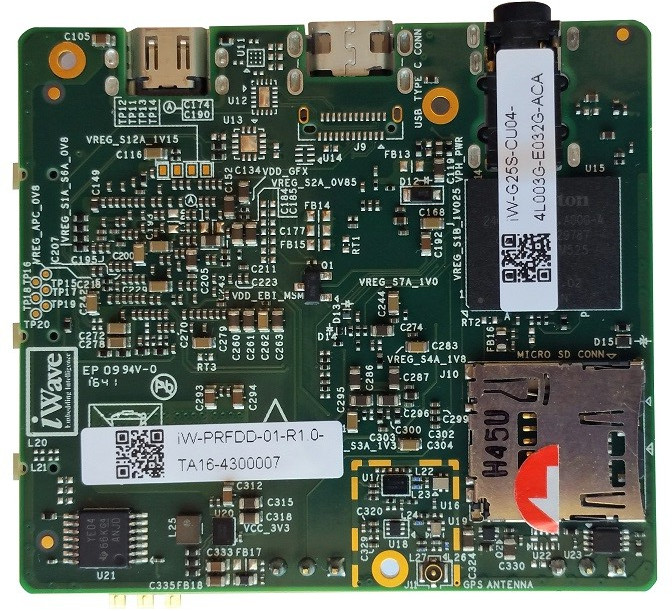 The company only mentions Android 6.0 Marshmallow support for the board, and expects it to be used for augmented & virtual reality applications, high end wearables,
The company only mentions Android 6.0 Marshmallow support for the board, and expects it to be used for augmented & virtual reality applications, high end wearables,
video analytics, 4K digital signage, 4K camera, connected home & entertainment, location based services, infrastructure management, indoor navigation, unmanned aerial vehicles (UAV), and other high-end embedded computing applications.
You’ll need to request a quote to get the price for the board, and you can do so, as well as get a few more details, on the product page.
Arrow Dragonboard 820c
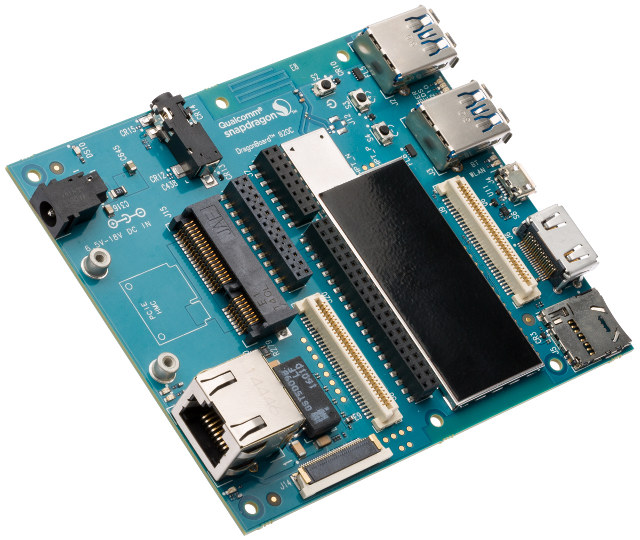
I first found out about DragonBoard 820c, when I covered DragonBoard 600c development board last summer, but at the time there was not enough information to write a separate article. The board has now been listed on Arrow, and appears very similar to 600c board, so we have a few more details including basic preliminary specifications:
- SoC – Qualcomm Snapdragon 820
- System Memory – 3 GB LPDDR4
- Storage – 32 GB UFS Flash + micro SD slot, maybe an mSATA slot?
- Video Output – HDMI 2.0
- Audio – Via HDMI, 3.5mm audio jack (TBC)
- Connectivity – Gigabit Ethernet, 802.11 b/g/n/ac WiFi, Bluetooth 4.1, GPS
- USB – 1x USB 2.0 port, 1x USB 3.0 port,
- Camera – Support for up to 3x image sensors up to 28 MP.
- Expansion
- 1x 40 pin low speed expansion connector
- 1x 60 pin high speed expansion connector
- 1x 16-pin & 40-pin audio expansion connector
- 1x 24 pin female header (not found on DragonBoard 600c)
- Misc – Volume, power & reset buttons. 6 LEDS (4x user, 1x Wifi, 1x Bluetooth)
- Power Supply – +6.5 – 18V DC input
- Dimensions – 100 x 100 mm compliant with 96Boards CE Extended specifications
The page on Arrow states that:
This board only supports the Android operating system at this time. There is NO Linux support for this board from Arrow, Qualcomm, or Linaro.org. Only the Hardware Manual and Android User Manual are available as documentation.
However, a Wiki page on Linaro website explains how to install Debian and Open Embedded on the board, and DragonBoard 820c is supported by the Yocto Project, or at least there’s work done on it.
Contrary to the other boards, DragonBoard 820c does not appear to be available just yet, and price is not known either.

Jean-Luc started CNX Software in 2010 as a part-time endeavor, before quitting his job as a software engineering manager, and starting to write daily news, and reviews full time later in 2011.
Support CNX Software! Donate via cryptocurrencies, become a Patron on Patreon, or purchase goods on Amazon or Aliexpress


